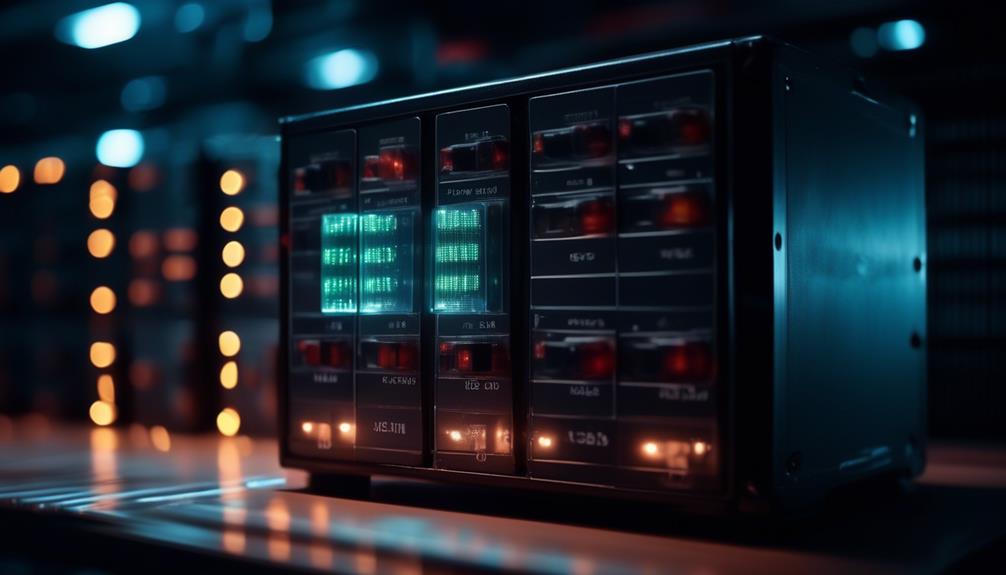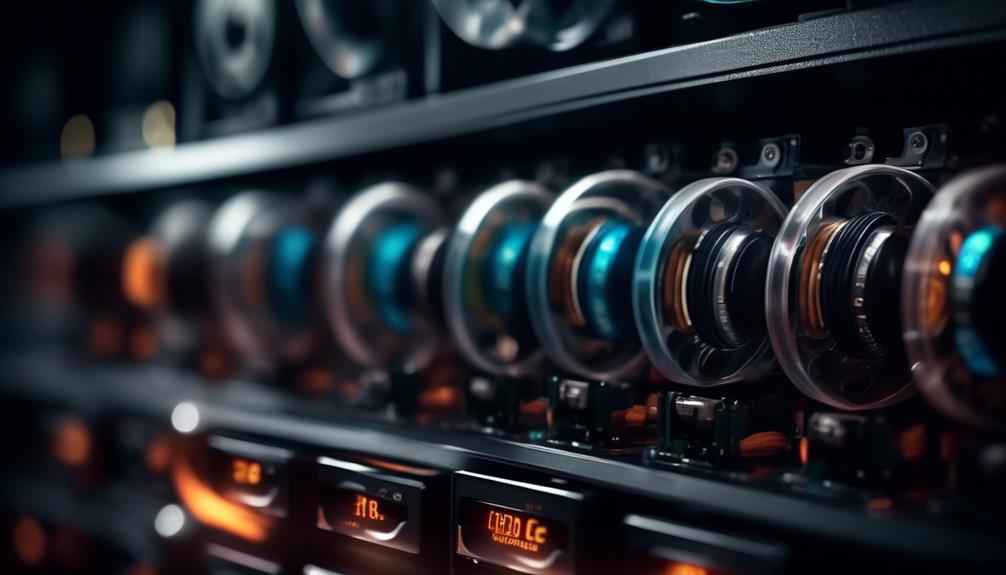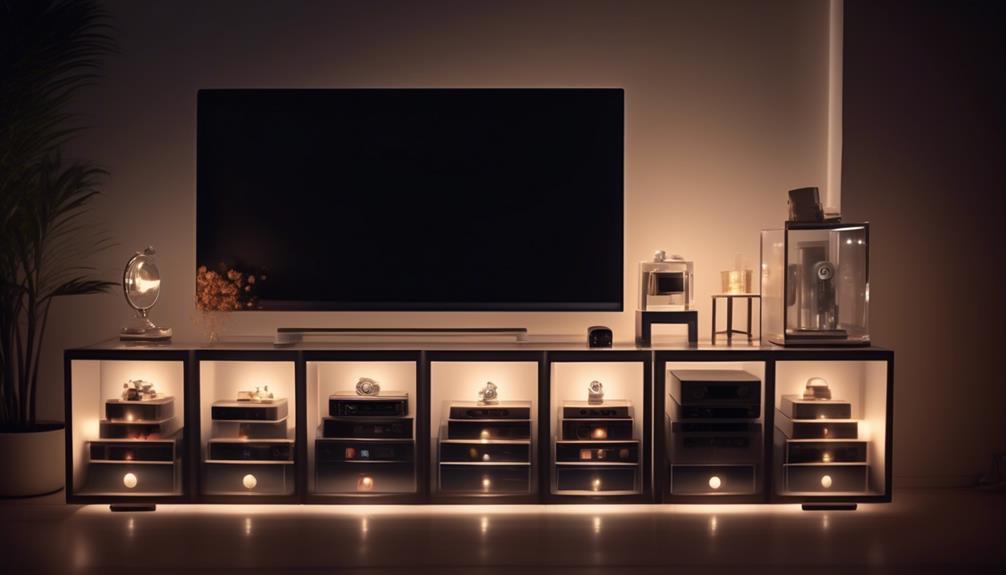JBOD, or Just a Bunch of Disks, is a popular storage solution for those seeking increased capacity and flexibility. However, one question that often arises is how much power does a JBOD consume when idle? The answer to this inquiry is not as straightforward as one might think, as various factors come into play. In this discussion, we will delve into the intricacies of JBOD power consumption, examining the factors that affect it and exploring ways to minimize power usage. Additionally, we will compare JBOD power consumption to other storage solutions, providing you with valuable insights into making informed decisions regarding your storage needs. So, let's embark on this enlightening journey and unravel the mysteries surrounding JBOD power usage.
Key Takeaways
- Power efficiency is crucial in data centers for cost and environmental considerations.
- Power-saving features in JBOD devices minimize energy usage during idle periods.
- Drive spin-down reduces power consumption when drives are not in use.
- Idle power consumption depends on the number and type of drives installed, as well as the JBOD design and components.
Understanding JBOD Power Consumption

Understanding the power consumption of a JBOD system is crucial in order to optimize energy usage and make informed decisions regarding its deployment and operation. Power efficiency is a key consideration in today's data centers, where energy costs and environmental concerns are at the forefront. By understanding how a JBOD system consumes power, organizations can implement power management techniques to minimize energy waste and maximize efficiency.
Power efficiency refers to the ratio of useful work output to the total energy input. In the context of a JBOD system, power efficiency can be measured by determining the power consumption of the system when it is idle. Idle power consumption is the amount of power consumed by the system when it is not actively performing data storage or retrieval tasks.
To optimize power efficiency, various power management techniques can be employed. These techniques aim to reduce power consumption during idle periods without sacrificing performance. One such technique is disk spin-down, which involves temporarily powering down idle disks to conserve energy. By intelligently monitoring disk activity and spinning down idle disks, organizations can significantly reduce power consumption without impacting data availability.
Another power management technique is smart power supply design, which incorporates features such as variable fan speeds and power-saving modes. These features ensure that the power supply operates at maximum efficiency, minimizing energy waste. Additionally, organizations can implement power management software that monitors and controls power usage, allowing administrators to optimize energy consumption based on workload demands.
Understanding the power consumption of a JBOD system and implementing power management techniques are essential for organizations looking to reduce energy costs and minimize their carbon footprint. By optimizing power efficiency, organizations can achieve significant cost savings while contributing to a more sustainable future.
Factors Affecting JBOD Power Usage
There are several factors that can affect the power usage of a JBOD system. One important factor is the presence of power-saving features, which can help reduce power consumption when the system is not in use. Another factor is drive spin-down, where the drives are automatically powered down when they are not being accessed, further reducing power usage. Finally, the idle power consumption of the JBOD system itself can vary depending on its design and components.
Power-Saving Features
To optimize power usage, JBOD devices incorporate various power-saving features. Power management is a crucial aspect of JBOD design, as it allows the device to efficiently regulate power consumption. These features enable the JBOD to minimize energy usage when not in active operation, such as during idle periods. Energy efficiency is achieved by implementing technologies like smart power management, which automatically adjusts power levels based on workload demands. Additionally, JBODs may utilize power-down modes that put non-essential components into a low-power state or completely power them off when not in use. These power-saving features not only reduce energy consumption but also contribute to prolonging the lifespan of the device and minimizing heat generation.
Drive Spin-Down
One key factor that significantly affects the power usage of a JBOD is the implementation of drive spin-down. Drive spin-down is a power management strategy that allows inactive drives to enter a sleep mode, reducing power consumption. Here are three important points to consider regarding drive spin-down and its impact on JBOD power usage:
- Power savings: By enabling drive spin-down, the JBOD can conserve energy when drives are not in use. This can lead to significant power savings, especially in scenarios where a large number of drives are present.
- Performance trade-off: While drive spin-down reduces power consumption, it can also result in increased latency when accessing data. It is important to strike a balance between power savings and performance requirements to ensure optimal system functionality.
- Configuration and customization: Drive spin-down settings can be configured based on specific needs and usage patterns. Some JBOD systems allow customization of spin-down timers or the ability to disable spin-down for certain drives, providing flexibility in power management strategies.
Idle Power Consumption
Idle power consumption of a JBOD is influenced by several factors that directly impact its overall power usage. Minimizing energy use and optimizing power efficiency are crucial in reducing idle power consumption. One factor that affects idle power consumption is the number of drives installed in the JBOD. The more drives there are, the higher the power consumption will be. Another factor is the type of drives used. Different drive models have varying power requirements, and using energy-efficient drives can help lower idle power consumption. Additionally, the design and components of the JBOD itself play a significant role. JBODs with power-saving features, such as drive spin-down or power management settings, can further reduce idle power consumption. By considering these factors, users can make informed choices to minimize energy use and improve power efficiency in their JBOD systems.
Typical Power Consumption of Idle JBODs
The power consumption of JBODs during periods of inactivity is a significant factor to consider when evaluating their overall energy efficiency. While JBODs are designed to provide high storage capacity and data availability, they can consume a considerable amount of power even when not actively utilized. Understanding the typical power consumption of idle JBODs is essential for reducing energy consumption and optimizing power management techniques. Here are three key points to consider:
- Power requirements: Idle JBODs typically consume a certain amount of power to maintain their internal components, such as fans and controllers. This power consumption can vary depending on the specific model and configuration of the JBOD. It is important to consider this baseline power requirement when evaluating the overall energy efficiency of a JBOD solution.
- Energy-saving features: Many JBODs offer energy-saving features, such as power management settings and automatic disk spin-down. These features allow the JBOD to reduce power consumption during periods of inactivity by spinning down idle disks or entering low-power modes. Leveraging these features effectively can significantly reduce the power consumption of idle JBODs.
- Efficient power management: Implementing efficient power management techniques can further optimize the power consumption of idle JBODs. This may include scheduling regular maintenance tasks during off-peak hours or using power management software to monitor and control the power usage of JBODs. By actively managing power consumption, organizations can reduce energy costs and minimize their environmental footprint.
Impact of Drive Spinning on Power Consumption

Given the significant power consumption of idle JBODs, an important factor to consider is the impact of drive spinning on power consumption. When the drives in a JBOD are idle, they typically consume a significant amount of power. However, when the drives are spinning, their power consumption increases further.
One factor that affects the power consumption of spinning drives is the drive temperature. As the drive spins, it generates heat, which in turn increases its power consumption. Higher drive temperatures require more power to maintain the spinning motion and to cool the drive. Therefore, it is important to consider the impact of drive temperature on power consumption when evaluating the overall energy usage of a JBOD.
Another factor that influences power consumption is the drive capacity. Larger capacity drives tend to consume more power than smaller capacity drives. This is because larger drives have more platters and read/write heads, which require more power to operate. Additionally, larger drives often have higher rotational speeds, which also contribute to increased power consumption. Therefore, the impact of drive capacity on power consumption should be taken into account when assessing the energy efficiency of a JBOD.
Minimizing Power Usage in Idle JBODs
To minimize power usage in idle JBODs, several power-saving techniques can be implemented. One important aspect to consider is the idle power consumption of the JBOD system, which refers to the amount of power consumed when the drives are not actively being accessed. By optimizing the power management settings and using energy-efficient components, the idle power consumption can be reduced, resulting in improved efficiency and energy-saving in JBOD systems.
Power-Saving Techniques
Utilizing power-saving techniques is essential for minimizing power usage in idle JBODs. By implementing effective power management strategies and energy efficient design, organizations can significantly reduce their energy consumption and contribute to a more sustainable environment. Here are three power-saving techniques to consider:
- Power Management Settings: Configure the JBOD to enter a low-power mode when not in use. This can involve spinning down idle drives, adjusting fan speeds, and optimizing power supply usage.
- Drive Spindown: Set the JBOD to automatically spin down idle drives after a specified period of inactivity. This reduces power consumption while still allowing for quick access to data when needed.
- Intelligent Cooling: Implement intelligent cooling mechanisms that adjust fan speeds based on temperature sensors. This ensures that cooling is only active when necessary, saving energy and reducing noise levels.
Idle Power Consumption
By implementing power-saving techniques, organizations can effectively minimize power usage in idle JBODs, including reducing energy consumption through idle power consumption management. Idle power consumption refers to the amount of power consumed by a JBOD when it is not actively performing any tasks. It is important to reduce idle power as it can significantly contribute to overall energy consumption and operational costs. One factor that affects idle power consumption is temperature. Higher temperatures can increase power consumption due to the need for additional cooling mechanisms. Therefore, it is crucial to maintain optimal temperature levels in JBODs to minimize power usage. By implementing measures such as efficient cooling systems and temperature monitoring, organizations can successfully reduce idle power and promote energy efficiency in their JBODs.
Efficiency and Energy-Saving
Efficiency and energy-saving techniques play a crucial role in minimizing power usage in idle JBODs. By implementing energy efficient storage solutions and reducing power consumption, businesses can not only save on electricity costs but also contribute to a greener environment. Here are three key strategies to achieve energy efficiency in idle JBODs:
- Power management features: Utilize power management features offered by the JBOD system to optimize energy usage during idle periods. This may include features such as standby or sleep modes that reduce power consumption when the system is not in use.
- Intelligent cooling mechanisms: Implement intelligent cooling mechanisms that adjust fan speeds based on temperature requirements. This prevents unnecessary energy consumption by cooling components only when necessary.
- Efficient power supplies: Choose power supplies that have high energy efficiency ratings such as 80 Plus Platinum or Titanium certified. These power supplies minimize energy wastage and convert more of the input power into usable output power.
Comparing JBOD Power Consumption to Other Storage Solutions
Comparing the power consumption of a JBOD to other storage solutions provides valuable insights into their efficiency and operational costs. When considering power efficiency, it is important to evaluate the impact of cooling on power consumption as well.
In comparison to other storage solutions such as traditional RAID arrays or individual hard drives, JBODs generally consume less power. The reason for this is that JBODs typically consist of multiple hard drives connected together without any redundancy or data protection mechanisms. As a result, JBODs do not require the same level of power-hungry components like RAID controllers.
Additionally, JBODs do not have the overhead of maintaining parity information or performing complex calculations for data striping and mirroring. This simplicity translates into lower power consumption.
Furthermore, the impact of cooling on power consumption should not be overlooked. JBODs, being a collection of individual hard drives, generate less heat compared to traditional RAID arrays. This means that cooling requirements for JBODs are typically lower, resulting in reduced power consumption for cooling systems.
When comparing JBODs to other storage solutions, it is important to consider the specific needs of the storage environment. While JBODs may offer lower power consumption, they lack the redundancy and data protection capabilities of RAID arrays. Therefore, organizations should carefully evaluate their requirements and consider the trade-offs between power efficiency and data security before making a decision.
Frequently Asked Questions
What Is a JBOD and How Does It Differ From Other Storage Solutions?
A JBOD, or Just a Bunch of Disks, is a storage solution that combines multiple hard drives into a single logical unit. It differs from other storage solutions, such as RAID, in that it does not provide redundancy or data protection. However, it offers advantages in terms of scalability and cost-effectiveness. Regarding power consumption, a JBOD typically consumes less power compared to other storage solutions, contributing to overall energy efficiency in data centers and reducing operational costs.
Can the Power Consumption of a JBOD Vary Depending on the Number of Drives Installed?
The power consumption of a JBOD (Just a Bunch Of Drives) can indeed vary depending on the number of drives installed. Additionally, the RPM (rotations per minute) of the drives can also impact power consumption. Higher RPM drives tend to consume more power compared to lower RPM drives. Furthermore, different drive types, such as HDDs (hard disk drives) or SSDs (solid-state drives), can also have different power usage characteristics. Considering these factors, it is important to carefully assess the power requirements of a JBOD setup when planning for power management and efficiency.
Are There Any Specific Environmental Factors That Affect the Power Usage of a Jbod?
Environmental factors can indeed have an impact on the power usage of a JBOD (Just a Bunch Of Disks). One such factor is temperature. Higher temperatures can lead to increased power consumption as the JBOD's cooling systems have to work harder to maintain optimal operating conditions. Conversely, lower temperatures may result in lower power usage. It is therefore important to consider the environmental conditions in which a JBOD is deployed to ensure efficient power management and minimize energy consumption.
Is There a Recommended Way to Minimize the Power Consumption of an Idle Jbod?
To minimize the power consumption of an idle JBOD, it is recommended to implement energy-efficient configurations. This can include utilizing power management features such as spin-down or standby modes for idle disks, optimizing the cooling system to reduce energy usage, and implementing power-saving settings on the JBOD controller. Additionally, utilizing advanced power management tools and monitoring systems can help identify and address any potential power inefficiencies. By adopting these practices, organizations can reduce their environmental impact and lower operational costs.
How Does the Power Consumption of a JBOD Compare to Other Storage Solutions Like RAID or Nas?
The power consumption of a JBOD can vary depending on its specific configuration and components. However, when comparing power consumption between JBOD and SSD storage solutions, it is generally observed that SSDs consume less power. This can have a significant impact on the overall cost of storage solutions, as lower power consumption translates to lower energy bills. Therefore, considering power efficiency is important when selecting storage solutions to minimize operational costs and environmental impact.
Conclusion
In conclusion, understanding the power consumption of JBODs is essential for efficient storage solutions. Factors such as the number of drives and their spinning status greatly impact power usage. By minimizing power usage in idle JBODs, organizations can reduce their overall energy consumption. Additionally, comparing JBOD power consumption to other storage solutions can help inform decision-making regarding the most energy-efficient option. Ultimately, optimizing power usage in JBODs can contribute to environmentally friendly practices and cost savings.

